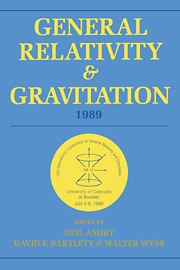 General Relativity and Gravitation, 1989
General Relativity and Gravitation, 1989 Book contents
- Frontmatter
- Contents
- Preface
- Conference committees
- Part A Classical relativity and gravitation theory
- WORKSHOPS
- Part B Relativistic astrophysics, early universe, and classical cosmology
- WORKSHOPS
- Part C Experimental gravitation and gravitational wave detection
- WORKSHOPS
- C1 Solar system and pulsar tests of gravitation
- C2 Earth-based gravitational experiments
- C3 Resonant bar and microwave gravitational wave experiments
- C4 Laser gravitational wave experiments
- Part D Quantum gravity, superstrings, quantum cosmology
- WORKSHOPS
- Part E Overviews-past, present, and future
C4 - Laser gravitational wave experiments
Published online by Cambridge University Press: 05 March 2012
- Frontmatter
- Contents
- Preface
- Conference committees
- Part A Classical relativity and gravitation theory
- WORKSHOPS
- Part B Relativistic astrophysics, early universe, and classical cosmology
- WORKSHOPS
- Part C Experimental gravitation and gravitational wave detection
- WORKSHOPS
- C1 Solar system and pulsar tests of gravitation
- C2 Earth-based gravitational experiments
- C3 Resonant bar and microwave gravitational wave experiments
- C4 Laser gravitational wave experiments
- Part D Quantum gravity, superstrings, quantum cosmology
- WORKSHOPS
- Part E Overviews-past, present, and future
Summary
Introduction
After 20 years of careful and innovative experimenting most of the researchers in the field of gravitational wave detection believe that success is on the horizon. Theoretical predictions of source strengths and source types have been steadily evolving and it is now clear that we should be aiming to build gravitational wave detectors which have strain sensitivities of ∼ 10-22 over kilohertz bandwidths. Such sensitivity should allow the detection of signals from, for example, supernova events at distances out to the Virgo cluster, coalescing compact binary systems and continuous and stochastic background sources.
One of the most promising ways of achieving the required sensitivity and bandwidth is to use laser interferometry between freely suspended test masses placed several kilometers apart, and the majority of contributions to the workshop on laser interferometer gravitational wave detectors were related to the large laser interferometer projects currently well advanced in planning. These instruments rely on searching for changes in the relative length of two paths, usually at right angles to each other, and formed between the test masses suspended as pendulums.
As will be mentioned again later, a number of interferometers are required around the world to obtain useful astrophysical information from the strength, polarization and timing of signals detected, and currently the belief is that at least three separate detector systems at different sites are necessary.
- Type
- Chapter
- Information
- General Relativity and Gravitation, 1989Proceedings of the 12th International Conference on General Relativity and Gravitation, pp. 357 - 366Publisher: Cambridge University PressPrint publication year: 1990


